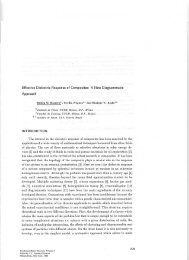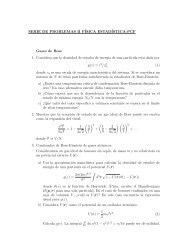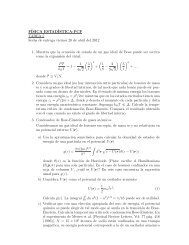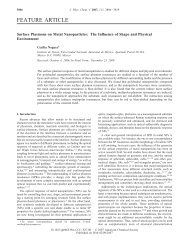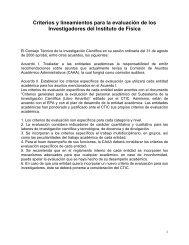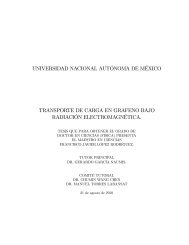Intrinsic Chirality in Bare Gold Nanoclusters: The Au34# Case - UNAM
Intrinsic Chirality in Bare Gold Nanoclusters: The Au34# Case - UNAM
Intrinsic Chirality in Bare Gold Nanoclusters: The Au34# Case - UNAM
You also want an ePaper? Increase the reach of your titles
YUMPU automatically turns print PDFs into web optimized ePapers that Google loves.
<strong>Intr<strong>in</strong>sic</strong> <strong>Chirality</strong> <strong>in</strong> <strong>Bare</strong> <strong>Gold</strong> <strong>Nanoclusters</strong> J. Phys. Chem. C, Vol. 112, No. 45, 2008 17537<br />
evenly distribution of normal modes is characteristic of the C 1<br />
isomer with respect to C 3 one. <strong>The</strong>se differences <strong>in</strong> the<br />
vibrational frequencies of chiral isomers of the Au - 34 cluster<br />
would be relevant if they can be coupled with the low-frequency<br />
modes of chiral molecules adsorbed on them, such that the<br />
correspond<strong>in</strong>g frequency shifts and l<strong>in</strong>e broaden<strong>in</strong>g could be<br />
detected us<strong>in</strong>g, for example, vibrational circular dichroism. 38<br />
<strong>The</strong> vibrational frequencies were used to calculate the zeropo<strong>in</strong>t<br />
energy contribution and the free energy <strong>in</strong> the harmonic<br />
approximation to analyze if there is any change <strong>in</strong> the energy<br />
order<strong>in</strong>g between the C 1 and C 3 isomers. Our results <strong>in</strong>dicated<br />
that the C 1 rema<strong>in</strong>s as the most stable one <strong>in</strong> a broad range of<br />
temperatures (at least up to 500 K).<br />
<strong>The</strong> calculated electronic density of states (DOS), obta<strong>in</strong>ed<br />
from the Kohn-Sham eigenvalues, is also displayed <strong>in</strong> Figure<br />
3 for the C 1 , C 3 , and C 3V isomers of the Au - 34 cluster. We found<br />
excellent agreement with the theoretically simulated PES spectra<br />
of the C 1 and C 3 isomers reported <strong>in</strong> ref 15 confirm<strong>in</strong>g the<br />
reliability of our DFT-GGA methodology. This agreement is<br />
not only obta<strong>in</strong>ed for the overall spectral patterns but also for<br />
the values of the HOMO-LUMO energy gaps. Our calculated<br />
values for these energy gaps are: 0.99 eV (C 1 ), 0.81 eV (C 3 ),<br />
and 0.58 eV (C 3V ). As was discussed <strong>in</strong> ref 15 because the DOS<br />
of the C 1 isomer shows better overall agreement with the PES<br />
experiment than the correspond<strong>in</strong>g DOS of the C 3 isomer, we<br />
confirm that the most likely candidate responsible of the<br />
observed PES would be the C 1 chiral isomer.<br />
<strong>The</strong> different features of the DOS exhibited by these isomers,<br />
<strong>in</strong> particular around the region of the HOMO-LUMO gap, may<br />
also be detected through optical spectroscopy. Figure 4 shows<br />
the optical absorption (upper panels) and CD spectra (lower<br />
panels) for the (a) C 1 , (b) C 3 , and (c) C 3V isomers. <strong>The</strong> electronic<br />
transitions from occupied to unoccupied molecular-like states<br />
start at about 0.9, 0.8, and 0.6 eV for the C 1 , C 3 , and C 3V isomers<br />
respectively, <strong>in</strong> consistency with the calculated HOMO-LUMO<br />
energy gaps. Moreover, the absorption spectra show well-def<strong>in</strong>ed<br />
features for each isomer. For <strong>in</strong>stance, whereas the spectrum<br />
of the C 3V isomer shows sharp peaks at 0.65, 0.95, and 1.35 eV<br />
(part c of Figure 4), the spectrum of C 1 shows a cont<strong>in</strong>ue band<br />
from 1 to 2.5 eV (part a of Figure 4). On the other hand, the<br />
absorption spectrum of the C 3 isomer shows an <strong>in</strong>termediate<br />
behavior between C 1 and C 3V because it shows a small peak at<br />
1.25 eV and a more <strong>in</strong>tense peak at 1.9 eV, where a cont<strong>in</strong>ue<br />
band starts, and f<strong>in</strong>ishes at about 2.2 eV (part b of Figure 4).<br />
<strong>The</strong> characteristic peaks <strong>in</strong> the optical absorption spectrum of<br />
the C 3V isomer are due to electronic transitions associated to<br />
the degenerate molecular-like electronic states (Figure 3). This<br />
degeneracy is orig<strong>in</strong>ated from the arrangement of the atoms <strong>in</strong><br />
this highly symmetric cluster. When the atomic symmetry is<br />
broken, the degeneracy is lost and the molecular-like electronic<br />
states are close enough such that the electronic transitions form<br />
optical bands, as observed <strong>in</strong> the spectrum of the C 1 isomer.<br />
This behavior can also be observed <strong>in</strong> the DOS shown <strong>in</strong> Figure<br />
3 for the 3 isomers. In the case of the C 3V isomer, the DOS<br />
shows well-def<strong>in</strong>ed peaks due to occupied and unoccupied states<br />
close to the Fermi level. On the other hand, the occupied states<br />
of the C 1 isomer form a band, whereas the C 3 isomer shows an<br />
<strong>in</strong>termediate behavior, where the occupied states are not close<br />
enough to form a band, but also they are not far apart to show<br />
s<strong>in</strong>gle peaks.<br />
<strong>The</strong> orig<strong>in</strong> of the optical spectra can be understood <strong>in</strong> terms<br />
of the calculated Kohn-Sham atomic orbitals with<strong>in</strong> the DFT<br />
scheme used for the anionic isomers. For the three isomers, the<br />
states around the HOMO are ma<strong>in</strong>ly composed of 5d and 6s<br />
Figure 4. Imag<strong>in</strong>ary part of the polarizability per volume unit (upper<br />
panels) and circular dichroism spectra (lower panels) of the (a) C 1 (blue),<br />
(b) C 3 (black), and (c) C 3V (red) isomers of the Au 34- cluster. A Gaussian<br />
broaden<strong>in</strong>g of 0.05 eV was employed for all of the spectra. <strong>The</strong> relation<br />
between the theoretical expression for the rotational strength given <strong>in</strong><br />
the text, and the calculated CD values reported <strong>in</strong> Figure 4 are discussed<br />
<strong>in</strong> the Support<strong>in</strong>g Information section. In the units of ∆ɛ for the CD<br />
curves, L means liters.<br />
orbitals with small 6p orbital contributions, whereas above 5<br />
eV <strong>in</strong> the DOS, the 5d orbitals dom<strong>in</strong>ate the occupied molecularlike<br />
states (Figures SP1 and SP2 <strong>in</strong> the Support<strong>in</strong>g Information).<br />
<strong>The</strong> lowest LUMO states, below 4 eV <strong>in</strong> the DOS (Figures SP1<br />
and SP2), are ma<strong>in</strong>ly composed of 6s orbitals, whereas the<br />
contribution of 5d and 6p orbitals is less important. Thus, the<br />
optical absorption at low energies ma<strong>in</strong>ly comes from molecularlike<br />
electronic transitions from 6s to 5d and 6p orbitals, and<br />
some contributions from the transitions from 5d to 6s and 6p<br />
orbitals. Above 3 eV, all of the absorption spectra show a tail<br />
due to electronic transitions from 5d to 6s and 6p electron states,<br />
ma<strong>in</strong>ly. <strong>The</strong> ma<strong>in</strong> features of our calculated optical spectra agree<br />
quite well with experiments and other calculations for similar<br />
structures like thiolate-protected Au 25 39,40 and Au 38 . 41 Notice<br />
that for the three isomers, strong quantum size effects are still<br />
present, with the cluster symmetry determ<strong>in</strong><strong>in</strong>g the energy<br />
location of the molecular-like electronic states, and the optical<br />
signature of each cluster. In contrast, gold nanoparticles have<br />
electronic bands, and collective electron excitations known as<br />
surface plasmon resonances are present.<br />
To corroborate the relationship between the optical response<br />
and the chiral cluster structure, the CD spectra of these isomers<br />
were calculated. <strong>The</strong> bottom panels of parts a, b, and c of Figure<br />
4 show these spectra for the C 1 , C 3 , and C 3V isomers,<br />
respectively. As expected, the C 3V isomer does not show any




